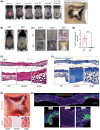TGFβ-mediated inhibition of hypodermal adipocyte progenitor differentiation promotes wound-induced skin fibrosis
- PMID: 39072821
- PMCID: PMC11693572
- DOI: 10.1111/cpr.13722
TGFβ-mediated inhibition of hypodermal adipocyte progenitor differentiation promotes wound-induced skin fibrosis
Abstract
Aberrant activation of dermal fibroblasts during wound healing often leads to debilitating fibrotic changes in the skin, such as scleroderma and keloids. However, the underlying cellular and molecular mechanisms remain elusive. Here, we established a wound-induced skin fibrosis (WISF) mouse model in mature adult mice, characterised by excessive deposition of collagen bundles, loss of dermal adipocytes, and enrichment of DPP4+Ly6A+THY1+ hypodermal interstitial adipocyte progenitors (HI-APs) and pericytes, resembling human fibrotic skin diseases. This WISF model exhibited an age-dependent gain of fibrotic characteristics, contrasting with the wound-induced hair neogenesis observed in younger mice. Through comprehensive analyses of the WISF, we delineated a trajectory of fibroblast differentiation that originates from HI-APs. These progenitors highly expressed several extracellular matrix (ECM) genes and exhibited a TGFβ pathway signature. TGFβ was identified as the key signal to inhibit the adipogenic potential and maintain the fibrogenic potential of dermal APs. Additionally, administering a TGFβ receptor inhibitor to wound scar reduced the abundance of ECM-producing APs. Finally, analysis of human scleroderma skin tissues revealed a negative correlation between the expression of AP-, ECM-, and TGFβ pathway-related genes and PPARG. Overall, this study establishes a wound-induced skin fibrosis mouse model and demonstrates that TGFβ-mediated blockage of HI-AP differentiation is crucial for driving fibrotic pathology. Targeting HI-APs and adipogenesis may provide novel avenues for developing disease-modifying therapies for fibrotic skin diseases.
© 2024 The Author(s). Cell Proliferation published by Beijing Institute for Stem Cell and Regenerative Medicine and John Wiley & Sons Ltd.
Conflict of interest statement
The authors declare no conflict of interest.
Figures








References
MeSH terms
Substances
Grants and funding
LinkOut - more resources
Full Text Sources
Miscellaneous

